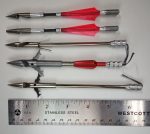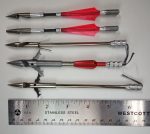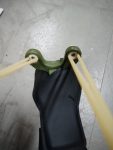Youth’s Lessons: The Slingshot – Part 5, by J.M.

(Continued
from
Part
4.)
If
you
want
to
easily
include
some
arrows
as
part
of
your
slingshot
carry
kit
without
worrying
about
how
to
store
and
carry
them,
PocketShot
makes
some
great
standard
and
bowfishing
3-section
take-down
arrows.
If
you
plan
on
going
after
larger
game
you
should
replace
the
field
tips
on
the
standard
arrows
with
broadheads.
As
an
aside,
since
slingshot
people
stole
arrows
from
archery
folks,
I
guess
some
turnabout
is
only
fair
–a
company
called
Shoottech
Systems
makes
a
dual-string
bow
with
a
magnetic
catch
on
the
string
that
allows
you
to
shoot
steel
balls
with
a
bow.
Darts
are
arrow’s
little
brother,
but
they
can
be
amazingly
effective
for
hunting
and
fishing
as
well
as
self-defense,
and
they’re
a
lot
more
portable
and
concealable.
These
are
typically
5”-6”
long
shafts
with
a
sharp
tip,
a
notch
for
hooking
it
to
the
band
string
and
a
knurled
tail
to
grip
when
you’re
drawing.
Like
arrows
they’re
available
with
fletching
for
hunting
(and
self-defense)
and
without
fletching
for
fishing.
My
favorite
hunting
dart
is
the
Sniper
Sling
Gen
2,
which
has
a
shaft
made
of
carbon
fiber
and
a
replaceable
tip.
They
weigh
around
.2
oz.
(6g),
which
is
a
little
more
than
a
7/16
steel
ball,
so
you
can
use
regular
bands
instead
of
heavy
ones,
but
they
have
amazing
accuracy
and
penetration
power
even
with
regular
bands.
Using
a
single
tapered
Theraband
Gold
band
with
a
dart
string
and
only
drawing
to
my
cheek
I
shot
one
at
½”
plywood
from
about
30’
away
and
the
dart
completely
penetrated
the
plywood
with
the
tip
sticking
out
around
¼”
on
the
other
side.
Here’s
a
video
of
some
guys
testing
them
out
with
similar
results.
The
darts
are
a
bit
more
expensive
($28
for
5),
but
worth
it.
If
you
ever
need
replacement
tips
you
can
contact
Sniper
Sling
via
email
and
they’ll
sell
you
some
for
$1.20
each
plus
shipping.
Fishing
darts
are
similar
but
are
usually
made
entirely
out
of
stainless
steel,
don’t
have
fletching
and
have
some
barbs
on
the
tip.
At
.7
oz.
(21g)
they
weigh
a
little
more
than
the
Sniper
Sling
darts
(roughly
the
same
as
an
11/16”
steel
ball),
so
you’ll
want
slightly
beefier
bands
to
use
them.
They
also
typically
have
a
hole
or
loop
on
the
back
end
for
attaching
your
fishing
line
to.
With
enough
practice
they’re
amazingly
effective.
Here’s
a
picture
showing
(from
top
to
bottom)
a
Sniper
Sling
Gen
2
sharp
point,
a
Sniper
Sling
Gen
2
blunt
point
(for
practice),
a
fixed-barb
fishing
dart
and
two
retractable-barb
fishing
darts.
You
can
find
the
fishing
darts
on
sites
like
eBay
and
AliExpress.
Another
option
is
to
make
your
own
darts,
and
it’s
pretty
easy
to
do
using
commonly
available
materials.
There
are
tons
of
DIY
article
and
videos
available
on
the
web
–
just
search
for
‘diy
slingshot
darts’.
CAUTION!
CAUTION!
CAUTION!
Shooting
darts
from
a
slingshot
can
be
a
very
effective
way
to
hunt,
fish
and
defend
yourself,
but
they
can
also
be
extremely
dangerous.
With
arrows,
the
tip
never
gets
behind
the
forks,
so
the
shooter
is
relatively
safe.
When
you
draw
and
release
a
dart,
the
razor
sharp
tip
is
flying
by
your
hand
and
fingers
at
nearly
its
maximum
velocity,
so
even
a
little
mistake
can
cause
a
serious
injury
–
if
you
doubt
that
and
have
a
strong
stomach,
try
searching
YouTube
for
‘slingshot
dart
injury’.
I
highly
recommend
that
you
get
comfortable
and
competent
shooting
regular
ammo
before
even
thinking
about
darts,
use
the
blunt
tip
Sniper
Sling
darts
or
grind
down
the
tip
of
a
couple
of
darts
smooth
for
practice,
and
wear
hand
protection.
Sniper
Sling
sells
several
protective
hand
covers
(I
use
their
Kevlar
one
in
the
field),
or
you
can
make
you
own
protective
cover
from
plastic
or
metal.
I
also
only
shoot
darts
with
a
hammer
grip
slingshot
(my
SimpleShot
Hammer)
to
keep
my
delicate
human
parts
as
far
away
from
the
path
of
travel
as
possible,
and
I
always
use
hand
protection.
Here’s
a
picture
of
my
dart-shooting
rig
and
my
hand
protected
with
the
Sniper
Sling
Kevlar
glove:
Message
of
Substance
The
third
category
of
slingshot
ammo
is
substance
delivery
–
that’s
where
you
use
a
slingshot
to
send
some
kind
of
liquid
or
powder
at
your
target.
The
most
obvious
example
of
this
is
paintballs,
which
can
be
loads
of
fun
to
shoot
with
a
slingshot.
Note
that
most
of
the
paintball
sites
and
forums
are
very
emphatic
that
you
should
never
shoot
a
paintball
with
a
slingshot,
as
you
can
cause
someone
an
injury.
I
tend
to
somewhat
skeptical
of
that,
since
in
the
US
paintball
guns
are
allowed
to
shoot
at
up
to
300fps,
which
is
well
beyond
what
most
people
can
shoot
with
a
typical
slingshot.
Paint
isn’t
the
only
substance
that
can
be
delivered
with
a
slingshot
–
you
can
buy
empty
paintball
shells
and
fill
them
with
whatever
you
want.
For
example,
you
could
fill
the
shells
with
a
stink
bomb
mixture
and
shoot
it
at
pests
that
won’t
stay
out
of
your
yard.
For
more
serious
situations
there
are
companies
that
sell
paintballs
filled
with
pepper
spray
and
tear
gas,
which
can
be
useful
if
you
need
a
non-lethal
ammo
alternative.
You
can
also
make
you
own
by
filling
the
shells
with
something
like
Capsaicin
powder.
If
you
hit
someone
with
it
the
shell
will
burst
open
and
the
powder
will
expand
into
a
small
cloud,
and
any
that
gets
on
the
target’s
skin,
eyes,
nose
or
mouth
can
instantly
incapacitate
them
(but
can
also
result
in
serious
harm).
Less
dangerous
options
such
as
powdered
Carolina
Reaper
powder
can
be
used,
or
you
can
dilute
the
Capsaicin
with
an
inert
powder.
Note
that
if
you
want
to
practice
this
I
highly
recommend
using
something
like
talcum
powder
instead
of
the
real
thing.
If
the
ball
and
substance
you’re
using
is
too
light
to
travel
an
effective
distance,
consider
mixing
in
some
small
lead
shot
to
add
weight.
And
since
I
know
someone
out
there
is
thinking
this,
no,
I
don’t
know
if
it’s
possible
to
make
flaming
or
exploding
balls.
Down
to
Business
Now
that
you
have
a
better
understanding
of
how
slingshots
work
and
the
options
available,
let’s
take
a
look
at
actually
shooting
one.
As
with
any
weapon,
the
first
thing
you
need
to
think
about
is
safety.
Here
are
some
safety
rules
everyone
should
follow
when
shooting
slingshots:
-
Always
be
aware
of
your
target
and
what’s
behind
and
around
it
–
Just
like
with
a
firearm
you’ll
be
sending
a
high-speed
projectile
down
range,
and
you
may
not
always
be
accurate.
Slingshots
have
a
much
wider
angle
of
potential
trajectory,
since
you
could
have
a
bad
release
or
the
ammo
could
deflect
off
the
fork,
causing
it
to
go
off
at
an
angle.
I
recommend
considering
everything
in
a
180°
arc
in
front
of
you
as
your
potential
impact
area
for
safety
purposes.
This
means
don’t
shoot
a
slingshot
in
the
living
room
with
your
target
hanging
near
the
glass
cabinet
containing
your
spouse’s
porcelain
cat
collection
and
be
aware
of
any
people
or
pets
wandering
around
the
area. -
Wear
safety
glasses
–
Slingshots
are
something
else
your
parents
were
right
about
–
you
can
put
someone’s
eye
out
with
one.
The
danger
isn’t
just
from
the
ammo
flying
around,
but
a
band
can
come
loose
or
break
when
you’re
drawing
it
and
snap
back
into
your
face,
which
could
do
some
serious
damage
to
your
eye.
Yes,
I
know
many
of
the
videos
I’ve
linked
to
in
this
article
show
people
shooting
without
eye
protection,
but
to
once
again
paraphrase
your
parents,
‘If
some
idiot
on
YouTube
jumped
off
a
cliff,
would
you?’ -
Inspect
your
slingshot
before
shooting
–
Check
out
the
bands,
frame
and
pouch
for
nicks,
tear,
breaks,
loose
band
connections,
etc.
Do
a
full
test
draw
on
your
bands
with
the
slingshot
held
low
so
if
the
band
breaks
it’s
not
coming
at
your
face.
I
also
do
a
quick
inspection
every
dozen
shots
or
so
in
case
a
problem
has
developed
while
I
was
shooting. -
Use
a
lanyard
–
Most
slingshots
have
a
hole
in
the
bottom
of
the
frame
for
a
lanyard,
and
you
should
loop
that
around
your
wrist
before
shooting.
If
you
draw
your
band
back
and
the
frame
slips
out
of
your
hand,
it
now
becomes
a
large
heavy
projectile
coming
right
at
your
face. -
Don’t
shoot
impaired
–
It’s
hard
to
focus
and
you’re
a
lot
more
likely
to
make
painful
mistakes
if
you’re
drunk,
sick,
tired,
injured
or
just
not
feeling
well.
Shooting
a
slingshot
is
definitely
not
a
‘hold
my
beer’
activity. -
Hand
protection
–
If
you’re
shooting
darts,
always
use
hand
protection.
When
you
first
receive
a
new
slingshot
you’ll
probably
be
tempted
to
slap
the
bands
on
and
start
shooting,
but
there
are
two
things
you
need
to
do
first:
-
RTM
–
Slingshots
may
seem
simple,
but
each
one
is
different
and
not
setting
it
up
or
using
it
correctly
can
have
a
significant
impact
on
your
safety
and
performance.
Read
the
instructions
that
came
with
it
and/or
check
out
the
vendor’s
web
site
for
additional
details
on
things
like
how
to
attach
the
bands,
the
best
grip,
etc. -
Bands
–
Most
slingshots
come
with
extra-long
bands,
so
as
discussed
earlier
you
need
to
figure
out
your
desired
elongation
and
draw
length
and
cut
your
bands
to
the
correct
length
before
attaching
them.
Before
you
start
practicing
you’ll
need
to
set
up
a
target.
You
can
buy
a
commercial
catch
box
(also
called
an
ammo
trap),
or
you
could
hang
up
a
sheet,
tarp
or
other
cloth
to
catch
your
ammo
and
suspend
your
target
in
front
of
that.
I
put
the
bottom
of
the
sheet
in
a
wide
plastic
bin
to
collect
the
ammo
and
keep
it
from
rolling
around.
Now
pick
up
your
slingshot
and
inspect
it
for
safety.
Regarding
which
hand
to
hold
it
in,
most
shooters
hold
the
slingshot
with
their
non-dominant
hand
and
draw
with
their
dominant
hand,
but
you
can
try
it
both
ways
and
use
what’s
most
comfortable
for
you.
For
example,
I’m
right-handed,
but
an
old
injury
to
my
left
elbow
causes
some
pain
when
I
fully
extend
it,
so
I’m
a
lot
more
comfortable
holding
with
my
right
hand
and
drawing
with
my
left.
If
the
bands
are
new
or
it’s
colder
where
you’re
shooting
you
can
stretch
the
bands
a
few
times
to
loosen
them
up.
If
it’s
a
new
slingshot
try
out
different
grips
and
practice
drawing
(without
ammo)
to
see
what’s
most
comfortable
for
you.
The
best
stance
to
start
with
is
standing
with
your
feet
perpendicular
to
the
target
about
shoulder
width
apart.
Most
people
hold
the
slingshot
sideways
with
the
grip
parallel
to
the
ground
(‘gansta’
style
for
you
gun
people),
although
some
folks
prefer
shooting
with
it
held
upright.
As
you
gain
more
experience
(and
additional
slingshots)
you
may
find
that
you
use
both
orientations,
depending
on
what
you’re
shooting.
I’m
not
going
to
go
over
the
actual
mechanics
of
loading,
aiming
and
shooting
a
slingshot,
since
there
are
a
lot
of
good
resources
available
that
cover
that
better
than
I
can
(and
this
article
is
already
really
long).
I
highly
recommend
Zachary
Fowler’s
‘How
to
shoot
a
slingshot’
video
as
an
excellent
starting
point
(the
videos
are
part
way
down
the
page
on
the
right
side).
One
recommendation
I
would
add
is
to
start
at
a
short
range
and
focus
on
your
draw,
aiming
and
release
mechanics
before
focusing
on
accuracy.
When
I
first
got
started
and
whenever
I
get
a
new
slingshot
I
start
at
a
distance
of
5’
and
use
a
piece
of
paper
with
a
bunch
of
½”
dots
drawn
on
it
as
a
target.
I
use
the
dots
as
aiming
points
and
keep
practicing
until
I
can
consistently
put
every
ball
into
a
1”
or
smaller
area;
note
that
I’m
only
using
the
dots
as
a
fixed
aiming
point,
not
the
actual
target.
My
initial
goal
is
precision
–
I
want
to
make
sure
my
draw,
aim,
and
release
are
consistent
enough
that
I
can
consistently
hit
the
exact
same
point
over
and
over
again
and
that
I’m
hitting
somewhere
close
to
where
I
expect
to.
I
also
note
the
offset
of
my
hits
grouping
relative
to
my
aiming
point
so
I
can
figure
out
where
I
need
to
actually
aim
to
hit
the
target.
Once
I’m
consistent
at
5’
I
move
back
to
10’
and
start
trying
for
accuracy
as
well
as
consistency.
When
I
get
accurate
at
10’
I
move
back
to
20’,
then
30’,
40’,
etc.
When
you
start
shooting
arrows
I
recommend
using
an
actual
archery
target,
since
a
hanging
sheet
won’t
stop
them
and
dedicated
archery
targets
are
designed
to
make
it
easier
to
remove
the
arrows.
For
shooting
darts
I
use
a
‘sandwich’
target
that
consists
of
2”
of
dense
foam,
then
two
or
three
layers
of
old
carpeting,
all
backed
by
¾”
plywood.
I
find
this
makes
it
easier
to
remove
the
darts.
Kitting
Up
If
you’ve
read
this
far
you
hopefully
have
a
better
understanding
of
modern
slingshots,
but
you’re
probably
scratching
your
head
on
the
best
way
to
wade
through
all
of
the
options
to
get
started
and
be
prepared.
I’ve
put
together
a
couple
of
suggested
options
based
on
the
following
requirements:
-
Cost
–
The
options
are
listed
from
low
to
high
in
terms
of
overall
investment. -
Expandability
–
The
ability
to
expand
the
system
to
support
future
requirements. -
Flexibility
–
The
ability
use
different
ammo
and
bands,
depending
on
the
situation. -
Ease
of
use
–
The
ability
to
reconfigure
things
easily
in
the
field.
The
absolute
least
expensive
option
is
to
DIY
your
own
slingshot
using
a
Y-shaped
tree
branch
or
other
Y-shaped
object
and
improvise
some
bands
out
of
available
elastic
with
a
duct
tape
pouch.
Ammo
can
be
any
small
heavy
objects
you
can
find
like
hex
nuts,
ball
bearings,
marbles,
etc.
The
problem
with
this
approach
is
that
you’ll
most
likely
end
up
with
inconsistent
results
depending
on
the
materials
you
use
to
build
your
slingshot,
which
may
impact
your
accuracy
and
power
and
cause
you
to
develop
some
bad
habits
or
get
frustrated.
You
can
improve
the
performance
by
using
a
pre-made
band
that
costs
around
$5.
While
this
approach
can
be
fun
and
rewarding,
I
recommend
that
you
start
with
a
commercial
slingshot,
which
will
allow
you
to
focus
on
learning
and
honing
your
aiming
and
shooting
skills
without
worrying
if
the
problem
is
you
or
your
slingshot.
Once
you’ve
acquired
good
skills
and
have
some
experience
you’ll
find
that
you
can
make
a
much
nicer
improvised
slingshot,
since
you’ll
be
able
to
more
confidently
identify
and
address
any
issues
with
your
design.
(To
be
concluded
tomorrow,
In
part
6.)


